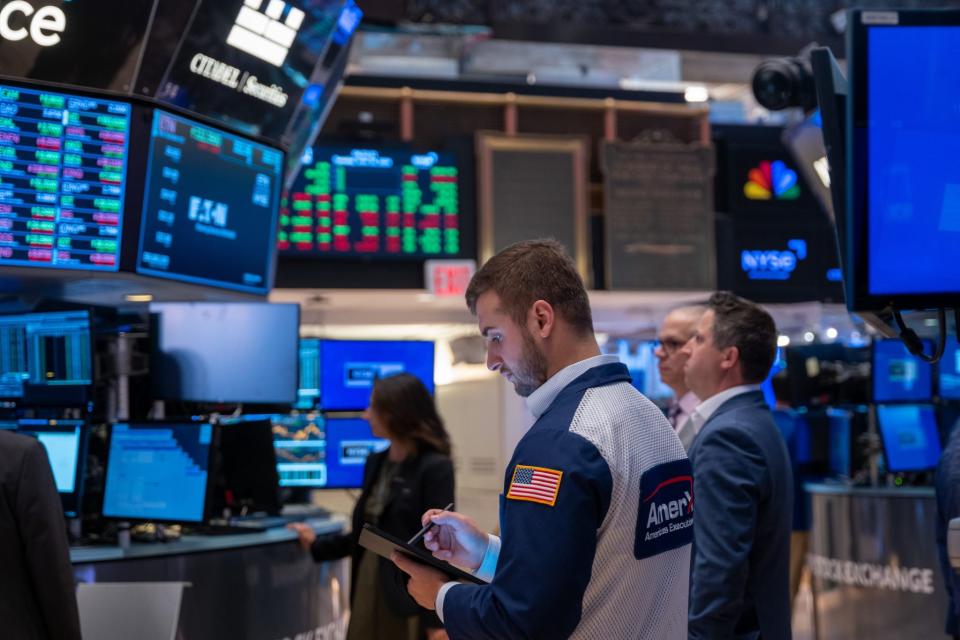Apollo’s chief economist calls the S&P 500 ‘vulnerable’ as it hovers just below all-time high of 5,523. Here’s what has him worried

The S&P 500 keeps hitting record highs, dominated by just a handful of stocks that are pushing it to ever greater heights. While that has investors celebrating now, the divergence between the valuations of those companies and some other key metrics has some on Wall Street ringing the alarm about an overconcentration risk.
The top 10 companies in the index make up 35% of the market cap and 23% of the earnings, according to Apollo Global Management chief economist Torsten Sløk. That disparity is making the S&P 500 is look “more vulnerable” than it has in decades, he wrote over the weekend.
“This divergence has never been bigger, suggesting that the market is record bullish on future earnings for the top 10 companies in the index,” Sløk writes. “The problem for the S&P 500 today is not only the high concentration but also the record-high bullishness on future earnings from a small group of companies.”
A decade ago, the top 10 companies accounted for around 14% of the index; today, it’s over one-third. Last year, the appreciation of the so-called Magnificent Seven—which includes tech behemoths <a href="https://fortune.com/2024/06/27/how-much-a-1000-investment-in-apple-stock-10-years-ago-would-be-worth-today/">Apple</a>, Amazon, Alphabet, Meta, Microsoft, Nvidia, and Tesla—accounted for half of the S&P’s total gains, according to Morgan Stanley.
Index investing is the go-to move for many retail investors. But because the size of the investment in each stock in the S&P 500 is based on the market capitalization of each company, even slight movements for those few firms can lead to outsize effects on an investor’s portfolio.
Just a handful of companies making up an even greater portion of the S&P’s total market capitalization means the performance of an investor’s portfolio is increasingly reliant on the performance of those few firms, negating the benefits of a broadly diversified stock index.
When those stocks are riding high, as they are now, investors are happy. But when the opposite inevitably occurs, investors will be at an increased risk.
Paul Dietrich, B. Riley Wealth Management’s chief investment strategist, is another financial expert who is telling investors to be cautious in the current market environment.
In a commentary titled “The Stock Market Bubble Is About to Burst—Look Out,” Dietrich warns that stocks often surge before a recession. When a bubble pops, it’s made all the worse because of emotion and excitement that superseded looking at the economic fundamentals of the investments. Investors trying to get in on the Nvidia hype now, for example, aren’t following the maxim to buy low and sell high. They could be buying at the height.
Dietrich also pointed to a host of out-of-whack metrics that suggest stocks are “bizarrely overvalued,” including the historically high price/earnings ratio for the S&P 500 (a high P/E typically indicates stocks are overvalued, while a low P/E points to the opposite) and historically low dividend yield (in this case, a lower yield points to an overvalued market).
Additionally, the “Buffett indicator” is flashing, Dietrich writes. Legendary investor Warren Buffett—who first outlined the indicator in Fortune in 2001—has been saying the market is overvalued, and is selling stocks while holding a record amount of cash and short-term Treasuries.
Buffett isn’t the only billionaire selling stock recently, Dietrich writes. Jeff Bezos, Bill Gates, Mark Zuckerberg, Jamie Dimon, and the Walton family have also been cashing in some of their company shares. “They are telling us something,” Dietrich writes. “What do they know that we don’t?”
Are stock market fears overblown?
Still, some on Wall Street say fears may be overblown. For one, Morgan Stanley’s recent report shows that this is not the first time the index has been so concentrated, and that “the S&P 500 has delivered returns above the average when concentration was rising and below the average when concentration was falling.”
In addition, most investors don’t hold their entire portfolios in the S&P 500—they diversify with other investments, including internationally. Many retail investors also opt for target-date funds in their 401(k)s, writes Morningstar’s John Rekenthaler, which have much less exposure to the Magnificent Seven.
This story was originally featured on Fortune.com

 Yahoo Finance
Yahoo Finance 